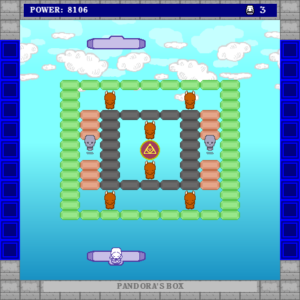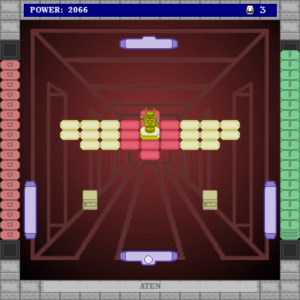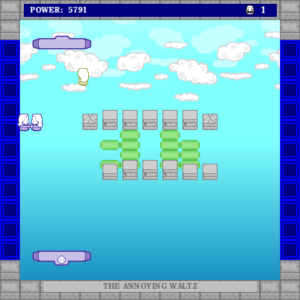Official Site || Game Jolt Page
Gemdance is a Breakout-style game with some interesting, if underused, mechanics and a focus on enemy variety. Our protagonist, a windup dancing toy named Galatea, takes the place of a ball as she bashes bricks and defeats demons in her attempt to escape her imprisonment in the world of Zodiac. Though Gemdance somewhat stumbles in its execution, contains plenty of creativity and charm.
As its name suggests, the world of Zodiac is divided into 12 areas based around each of the zodiac signs. Each area is, in turn, divided into four stages for a total of 48 stages in additional to a final boss. You can choose to tackle these areas in any order, but they are arranged in a circle with Aries being far and away the easiest and simplest of the lot and the overall difficulty gradually increases as you move clockwise from there.
There are many different enemies to be found in Gemdance and every area either introduces at least one new type of enemy or focuses on an enemy. The most common, and simplest, enemies are the Aries soldiers, who do not move on their own and primarily exist to get in your way; hitting a soldier makes it shuffle to the left or right and if they make contact with another soldier or object they vanish in a puff of smoke. The most interesting enemies are probably the lions in the Leo area, which shoot forth a steady stream of fireballs which Galatea will bounce off of. However, hitting a lion will knock it out for a few seconds and each of the Leo stages has one or more invincible walls, often surrounding a block or two, which only retract when every lion in the stage is simultaneously knocked out. Grim reapers are another cool enemy because they cannot be killed or stunned and if Galatea gets too close to one it will use its scythe to temporarily separate her head from her body; Galatea’s head and body are both able to destroy blocks and they will recombine if they touch each other, but you will lose a life if either one of them goes out of bounds. Other enemies, such as the rapidly-respawning fish primarily found in Pisces and the invincible horse archers introduced in Sagittarius, are not too dangerous or involved on their own, but they are often used alongside other enemies or in large groups.

Most of the monsters and especially Galatea have quite a bit of personality to them. Skulls chatter as they fly across the screen, archers take on a look of angry determination when they are about to launch an arrow, and most enemies open their eyes wide with surprise when they get hit. Galatea herself performs a little bow when she spawns in on the paddle before being launching into her spinning dance of brick-breaking destruction and she takes a moment to cry before disappearing when she goes out of bounds. The bricks themselves are rather plain, but this degree of detail carries over to other environmental obstacles, such as pillars which collapse and then become cracked after they are hit and bookshelves which gradually lose their books as they take damage. These graphical touches give Gemdance a much greater sense of charm than many other games in the genre with their often-sterile environments and abstract enemies.

Enemies aren’t the only form of variety this game has going for it as there are several interesting upgrades and mechanics to be found throughout, many of which are centered on giving players more things to keep track of. Galatea is larger than a standard ball, making her easier to catch with the paddle and easier to hit blocks with, and she doesn’t increase in speed unless you get a certain uncommon upgrade, but if you have three or more total lives remaining (i.e. the life counter is at ‘2’ since ‘0’ still counts) you can right click to send an additional copy of Galatea out into the field. Having multiple copies out makes it much harder to avoid losing a life, but in addition to simply saving time these copies are useful for dealing with many of the enemies, such as by making it easier to simultaneously knock out every lion in an area before the first one wakes up or for punching through a stream of arrows. In fact, the most common upgrade in the game is a plus symbol which immediately creates a new copy of Galatea on the paddle and the second most common upgrade is a guillotine symbol which spawns in a spinning scythe which cuts through bricks and can be bounced off of the paddle; this is very much a game which wants to encourage you to take the risk of juggling multiple objects over playing it safe with one at a time. The upgrades themselves are sometimes found after destroying certain containers, but the most common way of getting them is from hitting a snake enemy which periodically appears near the top of the screen. Other upgrades include an item which lets Galatea home in on blocks automatically for a few seconds, another which destroys every destructible block, yet another rare upgrade which simply clears the stage, and two relatively neutral upgrades for increasing or decreasing Galatea’s speed. Downgrades also exist in the form of a rather common one which cuts the paddle’s length in half if it’s touched and a more uncommon downgrade which summons in a grim reaper enemy.

If an area doesn’t introduce a new enemy, it definitely will make up for it by introducing a new mechanic. An early and common addition to the stages comes in the form of a red circle with a picture of a set of triangles. These circles cannot be destroyed and toggle between being lit or darkened when hit; completing a stage where circles are present requires you to toggle every circle to be simultaneously lit in addition to destroying every block. Another toggle mechanic is also introduced in later on where sets of green and red blocks will swap between descending into the ground and rising up to form impenetrable barricades each time you hit a statue. The Gemini stages have my favorite mechanic in the form of palette-swapped versions of Galatea, one for each copy of Galatea you’ve sent into the arena. These ‘evil’ versions of the protagonist do not destroy bricks, but if they make contact with a copy of Galatea they will grab her hands and spin her around in a waltz before letting go and sending her flying in a random direction. Though the Galatea ghosts may be my favorite mechanic, the most influential and innovative one by far is the presence of multiple paddles. Every stage has a paddle along the bottom wall, but several of them have an additional paddle on the ceiling and in a few cases there are even paddles on the sides or in the center of the screen. As every side with a paddle is also a side where Galatea can go out of bounds rather than bouncing off of a wall, the presence of these paddles makes it much more challenging to keep multiple copies of Galatea on the screen (not to mention the occasional scythe) and the added areas to keep track of somewhat balances out the fact that Galatea never moves particularly quickly.

For all of the interesting enemies and mechanics, Gemdance suffers from not taking its ideas far enough. This is most noticeable when it comes to bosses, which are almost consistently disappointing. Some areas don’t even have a boss enemy in their fourth and final stage, but the vast majority of the bosses which do exist don’t attack or interact with Galatea in any way and only stand in place or move slightly when hit; bosses are rarely more than glorified walls and many don’t even need to be defeated to clear the stage. The one exception to the rule is the boss of the Leo stages as not only do you need to defeat him to clear the stage, but defeating him involves first knocking out three lions to lower walls on either side of him and then hitting him to make him cross a lowered wall and stand in front of a lion, which will accidentally fry him to a crisp with a fireball once it wakes up. Though there is a gradual increase in difficulty, the game still remains easy throughout with fairly simple stages and plenty of extra lives. Furthermore, while some mechanics, such as the multiple paddles and the red circles, continue to pop up throughout the game, many of the mechanics and several of the enemies only appear within a specific set of four stages and nowhere else. Gemdance rarely gets to experiment with how it implements and combines its mechanics because many of them go away forever shortly after they appear. I wouldn’t consider Gemdance to be low on content with nearly 50 stages, but it definitely could have benefited greatly from having either a final set of stages to bring everything together or a more linear progression which would have allowed for a more steady increase in difficulty and more room for utilizing many of the monsters and gimmicks which are otherwise quickly cast aside.

In the end, Gemdance is a game which doesn’t quite live up to its high potential. However, even though it may not quite excel at its execution, it is a great game in its genre and still has plenty of entertainment to offer.